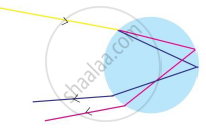Advertisements
Advertisements
प्रश्न
Draw a diagram, properly labelled, to illustrate the use of a total reflecting prism (a right-angled isosceles prism) to turn a ray of light through 180°. Name an instrument in which this device is used.
उत्तर
The diagram is shown below. This device is used in binoculars.

APPEARS IN
संबंधित प्रश्न
A light ray does not bend at the boundary in passing from one medium to the other medium if the angle of incident is ______.
i) Observe the given figure and answer the following questions.
a) Identify and write the natural process shown in the figure.
b) List the phenomena which are observe in this process.
c) Redraw the diagram and show above phenomena in it.

In the following figure, show two rays A and B travelling from water to air. If the critical angle for water- air surface is 48°, complete the ray diagram showing the refracted rays for each. State conditions when the ray will suffer total internal reflection.

A ray of light is incident on a glass surface at an angle of 50° with the corresponding angle of refraction 30°. Find the value of the R.I. of glass.
A green light is incident from the water to the air-water interface at the critical angle `(theta)`. Select the correct statement
For a ray of light, the critical angle is minimum when it travels from ______.
What is the phenomenon used in optical fiber? Explain.
State the condition under which total internal reflection occurs. Give the mathematical expression for total internal reflection.
Which of the following is used in optical fibres?
State two differences between normal reflection and total internal reflection.
